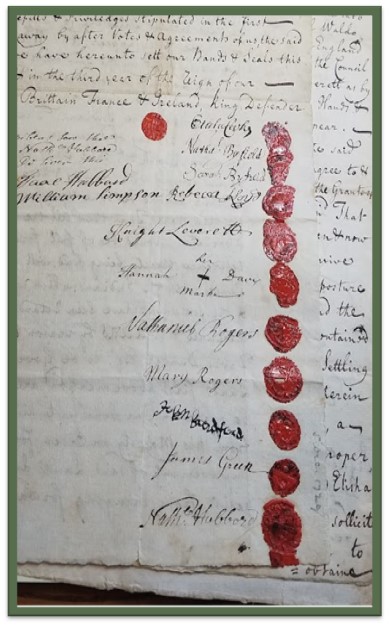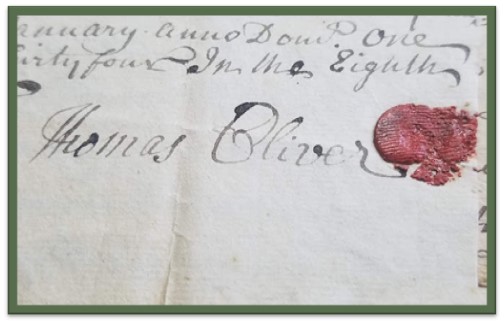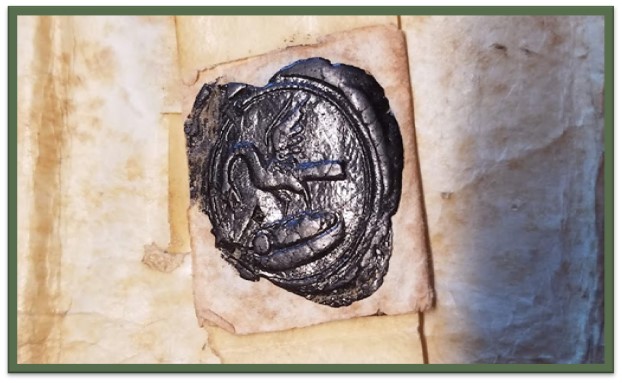By Daniel Bottino, Rutgers University and MHS Society of Colonial Wars in Massachusetts fellow
The MHS’s numerous collections of family papers contain folder after folder of 17th- and 18th-century legal documents, often described in collection guides as “estate papers”, “financial papers,” or “deeds etc.” Preserved here are the details of thousands of long-ago business transactions. In comparison with some of the MHS’s high-profile manuscripts—the letters of John and Abigail Adams, the journal of John Winthrop, the papers of Thomas Jefferson—these prosaic documents may seem at first glance to be of little historical value and, frankly, boring.

My recent research at the MHS has approached these documents from a new perspective: their wax seals. Throughout the entire colonial era and into the beginning of the nineteenth century, legal records required the imprinting of personal seals for validity. In theory, the imagery of every seal was unique, providing a foolproof verification of identity. This colonial practice of sealing possessed a long historical pedigree—a quick trip down the street to the Museum of Fine Arts reveals examples of ancient Mesopotamian seals more than three thousand years old imprinted into clay. A sealer in colonial New England possessed a stamping instrument or “matrix” into which the image of their seal was carved. In the process of sealing, this matrix would be pressed by hand into hot wax onto the paper, usually next to the sealer’s signature or mark. Matrices could be elaborate pieces of jewelry, carved of gold or silver and adorned with precious gems, carried attached to a watch or as a ring. Or, for people of more modest means, the simplest matrix was free—their own fingerprints.

Why have I chosen to study these seals, finding and photographing as many as I possibly can? Looking through hundreds of folders of legal records has revealed how integral the practice of sealing was to colonial legal culture, and by extension, colonial society as a whole. The ephemera of sealing culture is ubiquitous in the manuscripts I examine—pieces of broken and decayed seals often fall out when I open a folder, and stray splashes of sealing wax sometimes mark documents, evidence that a sealer’s matrix was impressed with force on an adjacent paper centuries ago. Seals are, of course, an inherently visual medium, their symbology capable of being interpreted even by illiterate colonists unable to read the text of legal documents. Their usage testifies to an often-overlooked element of New England colonial society—the fact that, into the 18th century, especially in rural areas, illiteracy was widespread. In such a society, very different from our own hyper-literate world, visual imagery, the materiality of objects, and ritually spoken words all played vital roles in legal transactions. Paying attention to how seals were used will enrich our understanding of this pre-modern society.

I am also intrigued by what seals can tell us on a more personal level. The design of each seal was specifically chosen by its owner to represent him or herself. What can these choices reveal about how colonial New Englanders understood their identities? Early in my research, I was struck by the imagery of Rebecca Winsor’s firmly impressed seal on a 1679 deed. At first, I was puzzled by what this strange looking bird could represent. But I am now confident that this seal portrays a mother pelican piercing her breast to shed blood for the nourishment of her offspring. This mythical behavior of the pelican is an ancient Christian symbolic representation of the sacrificial nature of motherhood. Rebecca Winsor was a mother of eight children whose husband had died shortly before this deed, in which she sold property to one of her sons. The symbolism of the sacrificial pelican is quite fitting for her life experience and was likely chosen by Mrs. Winsor herself. The seal’s black wax, rather than the normal red, is another touching piece of symbolism, for I believe it represents Mrs. Winsor’s mourning of her husband.
This seal is one of thousands in the MHS’s collections, hundreds of which I have photographed so far. Every seal has a story to tell, and if these stories can be unlocked, we will open a valuable window into a rich world of symbolism, ritual, and beliefs previously hidden from view.

